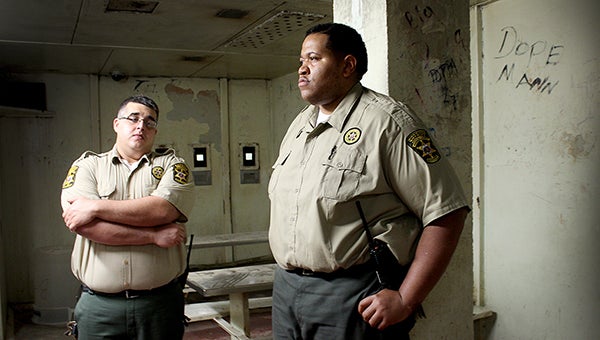Admittedly inadequate, there seems to be no interest in funding, building a new Warren County Jail
Published 10:15 pm Saturday, April 30, 2016

- OUT WITH THE OLD: Jailers Douglas Hadad and Franco Knox stand in an empty cell block in the Warren County Jail.
Most officials agree a new jail is in order for Warren County, but lack of funding has dashed any plans for a new jail in the foreseeable future.
The Warren County Jail, which once faced Cherry Street in the block between Grove and China streets, was built in 1907. The old hanging tower still looms above the building.
A lawsuit brought by a former inmate was settled in the 1970s and led to the construction of an addition in 1977 onto the original building. It changed the orientation of the jail from its front facing Cherry to Grove Street. The newer building abuts the original and both are still used today.
Once inmates were moved into the new jail addition, the original jail was gutted and renovated with cellblocks for juveniles and those arrested for misdemeanor offenses in the county, plus the addition of a new kitchen on the first floor and an open recreation room on the second.
Federal law now prohibits juveniles to be held in the same building as adult inmates.
Females were placed in the new portion of the first floor and the second floor of the new building was used for pretrial felony offenders in one cellblock, and city misdemeanors offenders in another.
Misdemeanor detainees are not supposed to be held in the same quarters as felony detainees said Warren County Sheriff Martin Pace. However, he said the jail today does not have the space to keep felony and misdemeanor detainees separated. Therefore, the Warren County Jail only holds felony offenders, Pace said.
“All we’re able to do is house pretrial felons — felony crimes charged and awaiting court,” the sheriff said. “We cannot house misdemeanor detainees because they can’t co-mingle with felons.”
Any arrest made in the county by any agency, such as Vicksburg Police, Mississippi Bureau of Narcotics, of others, is the responsibility of the county jail and sheriff’s office to house. That includes the care of the inmates, including doctor visits, mental health treatment, transportation and meals.
Jail by the numbers
The jail can house 128 inmates. With a 16- and 20-person cellblock closed down and 25 inmates sent to another county, the jail is at this time able to hold 92 total inmates.
As of Wednesday, the jail was housing 79 inmates — 57 are pretrial felony charged inmates and 22 are state inmates waiting to be picked up by the Mississippi Department of Corrections, which must be done within 30 days of the inmate’s conviction.
Though 79 inmates is a bit less than the 92 person capacity, the jail has to leave space available for new arrests that happen every day, and so there is a place for inmates to go if they need to be moved for fighting or whatever reason. The jail can never be truly full.
“It is not uncommon for us to house inmates in another county when we have reached our capacity,” Pace said.
The jail also has two detox tanks, with no beds or showers, for inebriated persons to stay until they have sobered up. There are also four holding cells not intended for long term stays but are places for vulnerable inmates or inmates with discipline problems to stay temporarily.
Maintenance
About six weeks ago the jail had to close two cellblocks for security reasons. The locking mechanism of individual cells was not working properly like a strand of Christmas lights that all stop working if one breaks. This issue was within the cellblock that is already in a barred area. The company that made the locks is out of business, the company that made the lock parts is also out of business and the man that made repairs has died. Other companies are now working to fabricate the parts needed to maintain the locking mechanism.
Because the jail never closes and is always occupied, it takes on wear and tear faster than the typical home or office. Routine maintenance happens often and with the inmates in these blocks sent to another county, the staff will have plumbing work and painting done in the empty cells.
“We’re just not able to do the work with the inmates on the inside of the jail,” Jail administrator Linda Pugh said.
She said the walls are supposed to be painted every year but the number of inmates sometimes makes it difficult.
“The longer it’s not done, the more it takes,” Pugh said.
She is in charge of the day-to-day functions of the jail. Pugh said the building is up to code, but maintenance is a constant reality with plumbers and welders coming in often. She said the fire marshals and health inspectors visit the jail every year.
For its age, she said the staff is getting everything out of the jail that can be expected, but it wouldn’t stack up to a new facility.
“The only problem we’re having now is doing the renovations,” Pugh said.
The inmates will be housed in another county until the renovations are complete.
Design problems
The main problem in the outdated jail, Pace said, is the linear cell design. When jailers look through the window of the cell door all they can see is a long hallway with each room lined up on the sides of the hall. A jailer has to walk down those halls to see any of the inmates.
“It’s impossible to adequately monitor inmates in this kind of design,” Pace said.
Pace said modern jails have a more open bay design with bedding around the walls in the open room where one person can see every inmate from a central location.
Approved jails can house some state inmates, or felony detainees who were sentenced in a trial, that can be utilized as working inmates or trustees under the supervision of the county. These inmates can pick up trash in the highways, assist city and county work crews and work as janitorial or maintenance staff in municipal buildings.
“We are no longer an approved facility by the Department of Corrections,” Pace said.
While the local jail once was certified to house these inmates, it is not anymore. The Department of Corrections is responsible for the housing of state inmates and will inspect facilities to see if the building meets the minimum requirements for safety, security and space.
Why? Because of the jail’s age and because it does not provide the square footage of space to house long-term sentenced state inmates.
Having state inmates benefits the county with free labor and the inmate will be able to take time off their sentence for the work they put into the community. Plus, it can benefit the inmates’ state of mind by having a job to do and completing it instead of sitting around for years.
Pretrial felony detainees cannot be used for labor outside of the jail grounds.
“It is against the law to work pretrial detainees outside,” Pace said.
The local jail does use pretrial detainees to cook, clean and maintain the jail itself. The sheriff’s office does not have the budget to pay for a janitorial staff.
“Working inmates are the lifeblood of any correctional facility as far as janitorial work and maintenance,” Pace said.
Pace called them his best employees saying they keep the floors waxed, help deliver meals to the other inmates, do the laundry and other projects along with deputies to keep the place running.
Currently the jail utilizes the first and second floor with pretrial felony suspects.
Pace said it would be possible to add more cells on the third floor, but at this time the floor does not have elevator access, heat, air, water or plumbing and would have to be built to current standards unlike the rest of the building that has been grandfathered in under old guidelines. He said the laundry and kitchen are already stretched to accommodate the amount of inmates the jail already holds and would need to be expanded also if the third floor was utilized.
New facility decisions, like raising taxes
All building decisions in the county fall in the hands of the Board of Supervisors.
The National Institute of Corrections did an in-depth review of the current jail in August 2006. Based on the institute’s report, the consulting firm Voorhis/Robertson Justice Services Inc. was hired in 2008 to write a jail needs assessment report for the construction of a new jail. The report was finish in April 2010.
“It was quite a lengthy report with a lot of valuable pertinent information,” said Richard George, president of the Warren County Board of Supervisors. “It was a well done report with options on type of construction and the size of the facility.”
He said the timing of the report roughly coincided with an economic downturn in Warren County.
“What we looked at and are still dealing with is the cost of a new facility and how we would retire the debt plus the increase in operations costs of a facility that’s larger than the one you have,” George said.
He said operations costs would probably go up if a larger facility were built. Building a jail, he said, could be done on a bond issue that taxes would eventually pay back over time, but his concern is being able to pay for a new jail and not being able to afford its daily operations costs.
Pace and George say one possibility is to pay a company to fund the construction of a new facility and then the county would lease it from them.
“The only problem with that is you still have to pay for the facility and you still have to operate it and that difference in your budgetary costs conflicts with your ability to raise taxes in a given year,” George said.
He said the value of a mil was $528,675 in 2010 when the board received the report. In 2015 the value of a mil was $523,906 dropping about $5,000. He said it is restrictive when trying to plan a large expenditure and there is no growth trend.
“Your value of your millage is what your tax rate is based on,” George said. “If I’m taxing you by the value of your property and your property value goes down, then just to stay the same I have to raise taxes. That’s the problem.”
In 2016, the value has jumped up to $529,269. George said money would have to go to the Vicksburg Warren School District before anywhere else. He wants to make sure the economy is secure before giving the green light for a new jail.
“The economy really and truly needs to be on the upswing when we make that move for the taxpayers’ sake,” George said.
While he does not want to increase taxes, he does know something has to be done about the jail sooner rather than later. If for no other reason, he said for the jail employees’ safety.
“There’s no question we do need a new jail. It’s a matter of when is the economy going to make it the most palatable to finance the effort,” George said.
Do we really need a new jail?
Pace understands the financial constraints, but has seen the jail’s decline for years.
“I don’t want taxes to go up any more than any other taxpayer, but I have a unique view working in this building for 31 years and this facility is undersize and outdated,” Pace said.
He said the county needs a facility that can serve the community well into the future that is of an adequate size and is safe for the inmates and the jail employees.
“This building has long outlived its usefulness to this community,” Pace said.
Records show for at least the past 12 years, and probably longer, grand juries have requested a new jail in their report.
“Ever since I’ve been on the bench, it’s been in the report,” Circuit Court Judge M. James Chaney Jr. said.
Warren County holds grand jury four times a year and the jurors are required to take a tour of the jail with the sheriff, Chaney said.
District Attorney Ricky Smith said a new jail was the number one recommendation for years but the request has since moved further down the list because juries are not confident a new jail is a possibility.
“About a year ago they decided the request wasn’t getting anywhere,” Smith said.
Smith said the president of the Board of Supervisors also speaks with the grand jury during their week of service. The president is often asked about a new jail, and the financial statistics are laid out to explain the reasoning behind the hold up.
“The board is hesitant to raise taxes and I understand that,” Smith said.
He said a new jail could solve two problems because the courthouse is also out of space and he believes the old jail could be used for offices and another court room.
“I have been a proponent of a new jail,” Smith said.
There are two circuit court judges and three assistant district attorneys and with a second courtroom more trials could be conducted in less time.
“We have the man power to operate two courtrooms at once,” Smith said.
Smith is concerned with the wellbeing of the jail employees.
“The jail conditions are deplorable,” Smith said.
Other things to consider
There are many things to think about when addressing building a new jail. First, the location is important. The law says a county jail must be in the city limits of its county seat. But George said it is possible to ask for permission from the legislature to have the jail located in the county and it is something the board has considered while looking at about seven different locations.
The location also brings up the issue of transportation of inmates to court. However, Chaney and Smith both say that telecommunication through remote access is a possibility for certain court hearings where inmates can use tools like Skype from the jail for preliminary proceedings.
Smith said it would increase courthouse safety as well as help transportation costs.
The county still has issues to work out when it comes to the construction of a new jail.
“The ramifications of an ill-timed move could be disastrous,” George said.
George said the Tax Assessor Ben Luckett would announce the newest millage value for the coming year at the board meeting on the first Monday in July.
“How those values calculate will reveal whether we’ve had any sustained growth or not,” George said.





